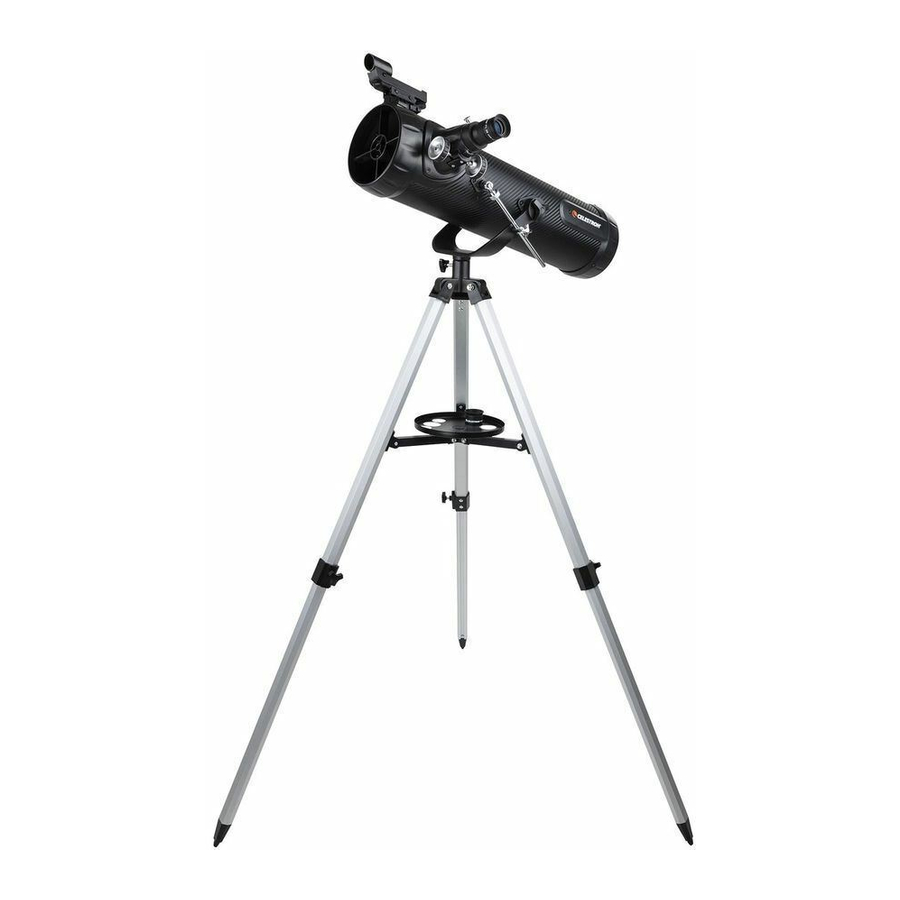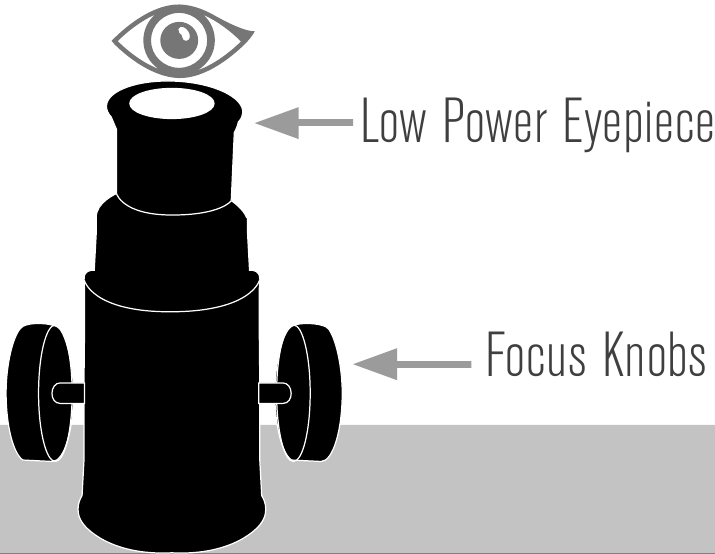Advertisement

Package Contents
Unpack your telescope and verify that all parts are present. Your 114AZ-SR Telescope includes: a telescope tube, a tripod and mount head, an accessory tray, two eyepieces, a red-dot finderscope, and a smartphone adapter.

Setting up
- To set up the tripod, spread the legs outward until they are fully extended and push down center leg brace.
![Celestron - 114AZ-SR - SETTING UP - Step 1 - Spreading the legs SETTING UP - Step 1 - Spreading the legs]()
- To extend the legs of the tripod, turn the locking knob on each leg section counterclockwise to loosen. Then, pull the lower leg section all the way out and retighten the locking knob to secure the leg in place.
![Celestron - 114AZ-SR - SETTING UP - Step 2 - Extending the legs SETTING UP - Step 2 - Extending the legs]()
- Attach the accessory tray by placing the threaded post on the bottom of the tray into the threaded hole in the center of the leg brace. Turn the entire accessory tray clockwise until it is fully seated. If necessary, you may rotate the tray counterclockwise slightly so that the eyepieces holders in the tray are not blocked by the leg brace arms.
![Celestron - 114AZ-SR - SETTING UP - Step 3 SETTING UP - Step 3]()
- While holding the telescope tube above the altazimuth mount, insert the end of the long silver altitude slow motion rod on the left side of the optical tube into the rod guide on the left fork arm of the mount.
![Celestron - 114AZ-SR - SETTING UP - Step 4 SETTING UP - Step 4]()
- Lower the telescope tube until the two altitude hubs on either side of the tube slide into the notches at the top of the fork arms.
![Celestron - 114AZ-SR - SETTING UP - Step 5 SETTING UP - Step 5]()
- Tighten the silver locking knob on the rod guide, then thread the two telescope mounting hand bolts through the fork arms and into the two altitude hubs on the telescope tube. They need to be snug, but do not overtighten.
![Celestron - 114AZ-SR - SETTING UP - Step 6 SETTING UP - Step 6]()
- Remove the cap from the focuser and make sure the two thumbscrews do not protrude into the opening.
![Celestron - 114AZ-SR - SETTING UP - Step 7 - Remove the focuser cap SETTING UP - Step 7 - Remove the focuser cap]()
- Insert the barrel of the 26mm eyepiece into the focuser and tighten the setscrew to secure it in place.
![Celestron - 114AZ-SR - SETTING UP - Step 8 SETTING UP - Step 8]()
- Locate the finderscope and loosen the two Phillips head screws on the right side of the finderscope. Slide the finderscope over the bracket on the telescope tube and tighten the Phillips head screws to secure the finderscope to the rail.
![Celestron - 114AZ-SR - SETTING UP - Step 9 SETTING UP - Step 9]()
- Remove the large lens cap from the front of the telescope. To observe, look through the eyepiece as shown above. Focus the image by turning the focusing knobs below the focuser.
![Celestron - 114AZ-SR - SETTING UP - Step 10 - Focusing the image SETTING UP - Step 10 - Focusing the image]()
- For additional magnification, you can swap out the 26mm eyepiece for the 9.7mm eyepiece. This will increase your magnification from 23x to 62x.
![Celestron - 114AZ-SR - SETTING UP - Step 11 - Additional magnification SETTING UP - Step 11 - Additional magnification]()
- To move the scope right and left, hold a tripod leg with one hand while the other hand uses the panning handle to move the scope as required. The azimuth locking screw can be loosened or tightened to adjust the tension to your preference.
![Celestron - 114AZ-SR - SETTING UP - Step 12 - Turning the scope SETTING UP - Step 12 - Turning the scope]()
- To move the scope up and down over large distances, loosen the silver locking knob on the rod guide. Use one hand to manually move the scope to the desired angle and secure it in place by tightening the silver locking screw.
![Celestron - 114AZ-SR - SETTING UP - Step 13 - Moving the scape SETTING UP - Step 13 - Moving the scape]()
- To move the scope up and down in fine increments, keep the locking knob on the rod guide tightened and simply rotate the silver knurled knob on the altitude slow motion rod.
This allows for fine adjustment when centering a target or when tracking a celestial target as it appears to drift across the night sky.
![Celestron - 114AZ-SR - SETTING UP - Step 14 SETTING UP - Step 14]()
NOTE: The slow motion rod has a limited range of motion. If you hit one of the stops, you can reset the rod by loosening the locking knob on the rod guide and then turning the slow motion knob until it is in the center of its travel. Tighten the locking knob and resume normal use.
Aligning the Finderscope
The finder is one of the most important parts of your telescope. It helps you locate objects and center them in the eyepiece. The first time you assemble your telescope, you need to align the finder to the telescope's main optics. It's best to do this during the day*.
*SOLAR WARNING! Never attempt to view the Sun through any telescope without a proper solar filter!
- CHOOSE A TARGET
Take the telescope outside during the day and find an easily recognizable object, like a streetlight, license plate or sign. The object should be as far away as possible, but at least a quarter mile away.
![Celestron - 114AZ-SR - Aligning the Finderscope - Step 1 Aligning the Finderscope - Step 1]()
- CENTER THE TARGET IN THE EYEPIECE
Look through the telescope using your lower power 26mm eyepiece. Move the telescope until the object you chose lies in the center of the view. If the image is blurry, gently turn the focus knobs on either side of the telescope until it comes into sharp focus.
![Celestron - 114AZ-SR - Aligning the Finderscope - Step 2 - Center target Aligning the Finderscope - Step 2 - Center target]()
- LOOK THROUGH FINDERSCOPE
Once the object is centered in your 26mm eyepiece, look through the finderscope and locate the red dot
![Celestron - 114AZ-SR - Aligning the Finderscope - Step 3 Aligning the Finderscope - Step 3]()
- ADJUST THE FINDERSCOPE
Without moving the telescope, use the two adjustment screws on the finderscope to move the red dot appears over the object you are observing in the telescope's 26 mm eyepiece.
![Celestron - 114AZ-SR - Aligning the Finderscope - Step 4 Aligning the Finderscope - Step 4]()
TIP: Try adjusting one screw at a time. Loosen one screw by half a turn and tighten another by the same amount to ensure the finderscope is securely held in place. - YOUR FINDERSCOPE IS NOW ALIGNED!
It should not require realignment unless it is bumped or dropped.
![Celestron - 114AZ-SR - Aligning the Finderscope - Step 5 Aligning the Finderscope - Step 5]()
Using the Smartphone Adapter
- Lift the bungee straps and slide your smartphone between the straps and the adapter body so that the camera is looking through the camera opening. The straps should provide plenty of tension to hold the device securely against the adapter.
![Celestron - 114AZ-SR - Using the Smartphone Adapter - Step 1 Using the Smartphone Adapter - Step 1]()
- Loosen the setscrews on the eyepiece holder on the bottom side of the adapter. Place the black portion of the eyepiece into the eyepiece holder and tighten the screws to secure the eyepiece in place.
![Celestron - 114AZ-SR - Using the Smartphone Adapter - Step 2 Using the Smartphone Adapter - Step 2]()
NOTE: You may have to remove the rubber eyecups from the eyepiece. - Now take the adapter with the phone and eyepiece attached and insert the chrome barrel of the eyepiece into the focuser of the telescope. Secure it in place by tightening the setscrews on the focuser.
![Celestron - 114AZ-SR - Using the Smartphone Adapter - Step 3 Using the Smartphone Adapter - Step 3]()
- Activate the camera app on your smartphone and adjust the focus, just as you would with an eyepiece, using the image that appears on your phone's screen.
![Celestron - 114AZ-SR - Using the Smartphone Adapter - Step 4 Using the Smartphone Adapter - Step 4]()
NOTE: Make sure you turn the phone's flash is turned off.
Your First Night Out
The best and easiest target for you to view first is the Moon. Try observing the Moon at different points in its phase cycle. The best time to view the Moon is from two days after a New Moon up to a few days before a Full Moon. During this period, you will be able to see the most detail in the craters and lunar mountain ranges.
- With the Moon visible in the sky, set up your telescope as described above with the 26 mm eyepiece installed.
![Celestron - 114AZ-SR - Your First Night Out - Step 1 Your First Night Out - Step 1]()
- Move the telescope so that it is roughly pointing toward the Moon.
![Celestron - 114AZ-SR - Your First Night Out - Step 2 Your First Night Out - Step 2]()
- Look through the finderscope and locate the red dot. Continue moving the telescope until the red dot appears over the Moon.
![Celestron - 114AZ-SR - Your First Night Out - Step 3 - Locate the red dot Your First Night Out - Step 3 - Locate the red dot]()
- Look through the telescope's 26 mm eyepiece. Gently turn the focus knobs to adjust the sharpness of the image.
![Celestron - 114AZ-SR - Your First Night Out - Step 4 - Adjust a sharpness Your First Night Out - Step 4 - Adjust a sharpness]()
CONGRATULATIONS! YOU HAVE NOW OBSERVED YOUR FIRST CELESTIAL OBJECT!
To get a closer view of the Moon, loosen the setscrews on the focuser and remove the 26 mm eyepiece. Replace it with your 9.7 mm eyepiece and tighten the setscrews to secure it in place. The 9.7 mm eyepiece will give you significantly more magnification, making the Moon appear much larger.
NOTE: You may need to adjust the focus knobs when you change eyepieces, so make sure you are getting the sharpest image possible.
- You can view many other celestial objects, such as planets, star clusters and nebulae using this same technique if you know where to find them in the night sky. Celestron's free SkyPortal app for iOS and Android can help you locate and identify a wide array of celestial objects quickly and easily.
![Celestron - 114AZ-SR - Your First Night Out - Step 5 Your First Night Out - Step 5]()


Documents / ResourcesDownload manual
Here you can download full pdf version of manual, it may contain additional safety instructions, warranty information, FCC rules, etc.
Download Celestron 114AZ-SR - Smartphone Ready Reflector Telescope Quick Setup Guide
Advertisement
















































Need help?
Do you have a question about the 114AZ-SR and is the answer not in the manual?
Questions and answers